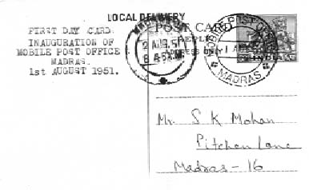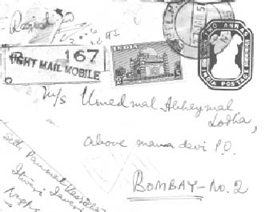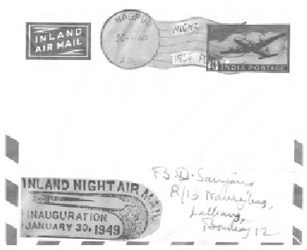Indian Postal History 1947-1997
by Ashok Kumar Bayanwala
16.
Night Air Mail Service, 30th January 1949
|
The "Night Air Mail Service" was introduced on 30th January 1949
by the then Communication Minister, Mr. Rafi Ahmed Kidwai, to rehabilitate
the deteriorating postal service. When the Railway Mail Service and Motor
Mail Service had reached saturation point, the only option left was to
introduce Air Mail Service for the First Class Mail. As day time air
service were running with full loads, night air service were planned.
Before this period, night flying was not safe in the absence of security
measures and equipment at Airports. The Night Air Mail scheme was an
experiment towards night flying in India and for the introduction of the
"All Up Scheme". Initially only mail was transported on N. A. S.
Night flying reduced considerably the time factor on mail from one place to
another. Aircraft flying from Trivandrum to Srinagar used to make night halts at
Madras and New Delhi. Now the mail can reach its destination on the next day. This scheme was strongly opposed by airline operators on various grounds. They wanted a guaranteed minimum payment, but the Government was not prepared to give such a guarantee, wishing to maintain the existing rates of carriage. Only Indian Overseas Airlines offered to work on the Government conditions. The Air Transport Licensing Board granted a licence for operation of Night
Airmail Service to Indian Overseas Air Lines Ltd.., for one month from 30th
January 1949. At that time Indian Overseas Airline Ltd., had traffic offices at
Ahmedabad, Bangalore, Bombay, Calcutta , Hyderabad, Jabalpur, Kanpur, Lucknow,
Madras and Nagpur. The routes on which this Company was operating at that time
were, It had 15 Dakotas and many other planes on or about 31st August 1948. The
milage flown and passengers carried during June 1948 were 83,394 and 1,186
respectively. The weight of freight and mail carried was 36,956lbs., and
1,423lbs. The licence for N.A.S., was extended upto 30th June 1949. Roughly
48,000lbs., of mail was carried during each of February and March 1949. After
the introduction of the All Up Air Mail Scheme on 1st April 1949, the amount of
mail was tripled. For some time it appeared that the day services had suffered
in the carriage of mail, but this was soon discounted by an overall increase of
air mail all over India.
To gather with All Up Scheme a novel scheme of utilizing Mobile Post Offices (MPO) was also introduced on 1st April 1949 in Nagpur, to achieve the full potentials of the NAS. The MPOs were located on strategic points in the city for collecting mail, including registered mail, until 8.30PM. Then the MPO vans used to go to the airport to deliver the mail directly for the NAS. Thus the mail posted upto 8.30PM in the city, can be delivered at about 10AM the next day, in other N.A.S., cities. Once MPO scheme was successful in Nagpur, MPO were opened in Bombay, Calcutta and Madras on 1st August 1951 and in New Delhi from 2nd October 1951. Slowly, MPOs were introduced in many other big cities and by 1953, MPOs were being run in 18 cities of India.
During May 1949, Indian Overseas Airlines Ltd., reached a critical financial position and had to give up Madras-Delhi NAS on 19th May 1949 and Calcutta - Bombay N.A.S., on 8th June 1949. The Madras - Nagpur sector was operated by Deccan Airways and Delhi - Nagpur sector by Indian National sectors remained closed until 30th June, when all night air services were suspended because of the Monsoon. The Government wanted to reopen N.A.S., from 1st October but could not do so as negotiations could not be finalized. Air India Ltd., Air Services of India Ltd., Deccan Airways Ltd., Airways (India) Ltd., and Indian National Airways Ltd., offered to run the N.A.S., at a guaranteed minimum payment of Rs.3/- per mile flown. Bharat airways Ltd., quoted a lower rate of Rs. 2 and As. 12 per mile. As the Government was unwilling to pay the minimum charge, none of these companies got the licence to run the N A S. Most of the scheduled companies strongly objected to the resumption of NAS, and termed it ill advised. It was a great test for the Government, which responded by giving a permit to
a non scheduled operator, Himalayan Aviation Ltd., who offered to operate
without any guarantee. Thus the N.A.S., was resumed on and from 15th October
1949, in spite of all opposition from scheduled operators.
This time same aircraft did not return to home base. The route was Bombay - Nagpur - Calcutta and Delhi - Nagpur - Madras and vice versa.
In connection with introduction of this service there have been considerable
changes in the hours of clearance of Letter Boxes, despatches and deliveries of
mails etc. Officers in charge of Post Officces and R.M.S., offices should
personally see to it that their office records are kept corrected upto date and
that correct information is furnished to the public in connection with any
enquiries that may be made. The revised hours should be notified to the public
on the office Notice Boards, Letter boxes etc. Care should be taken to see that
proper hours types are used in the date-stamps supplied to the delivery and
sorting branches and that all Letter Boxes are invariably cleared fully and
punctually. |
After the expiration of 3 months, Himalayan Aviation was allowed to renew its
licence until January 1951, and then until May 1951. From 1st June 1951, the
licence was granted to Deccan airways Ltd., which had become mainly a
nationalized company by that time. It remained with them until total
nationalization of all airlines companies on and from 1st August 1953. Thus the
N.A.S., was taken over by Indian Airlines Corporation, from which date they
carried it out very efficiently. In 1960 the N.A.S., came to a stand still when
DC-3 Dakotas being used on this service, were grounded. But the N.A.S.,
continued against all heavy odds. The N.A.S., continued until October 1973, when
the Indian Airlines Corporation decided to discontinue the Night Air Mail
Service, because of the low rates paid by the P & T Department. Actually
these rates had remained almost static for many years, despite the increase in
operational costs of the IAC.
The N.A.S., was reintroduced on 1st April 1975 between Madras and
Bombay, but it did not last long. And since then, many times the IAC have
restarted the N.A.S., but with similar results. Now, we should deal with cachet and cancellation pertaining to this service. A special Duplex Cancellation reading ?NIGHT MAIL / FIRST FLIGHT? and ?NAGPUR / 30.1.49 / AIR? in round circle was used on the inaugural day of the N.A.S., from Nagpur only. A special Supplementary Cachet was also used which reads ?INLAND NIGHT AIR MAIL / INAUGURATION / JANUARY 30, 1949?.
Besides the above, no special postmarks were used on Night Airmail and it very hard to tell whether a particular article had travelled by N.A.S. But evidences die hard. There are covers which speek by itself that they must have travelled by N.A.S., or otherwise they would not have reached the destination, the next day. My first example is from Calcutta to Jaipur city. The functioning of N.A.S., can be proved authentically only by a few Crash Covers from the different region involved. For example, I have mail from Bombay, Delhi, Jamnagar, Jodhpur, Nagpur, Madras, and Tumsar (near Nagpur), which were involve in a N.A.S., crash near Calcutta on 21st November 1951. If the N.A.S., was not working in the fashion I have described above, it was just impossible for mail of different cities (which are apart by thousands of miles) being involved in one air crash. These Crash Covers are scarce and are hard to find today. Now I will give details of N.A.S., crashes. The first disaster took place in the morning of 21st November 1951 near Calcutta, when a DC-3 Dakota of Deccan Airways coming from Nagpur struck a grove of coconut. 16 people out of 17, including the crew were killed. Only a small quantity of mail was salvaged. A 2 line cachet reading ?SALVAGED NIGHT AIRMAIL / DUM DUM CRASH 21ST NOV 51.? in a rectangular box was applied on such mail. As the first ?M? in Dum Dum was found to be missing, a new stamp was prepared, this time without the rectangular box. Examples are as under. Another example is from Jamnagar dated 20th November. It was posted at about 11AM. It appears that it was sent to Bombay - Jamnagar daily flight via Bhavnagar and Rajkot, as the All up Air Scheme was in vogue. Then, on reaching Bombay it was sent to Nagpur via N.A.S., where it was loaded on to the Calcutta bound N.A.S. 20th / 21st flight which was involved in the crash. Next example is from Jodhpur dated 19th November. It came to Delhi via Delhi - Jodhpur by daily flight via Jaipur and was loaded on N.A.S., on the 20th from Palam for Nagpur, so that it could be loaded on the Calcutta bound N.A.S. My one more example is from Tumsar, a place near Nagpur. It seems that it must have come to Nagpur by train, then loaded on to the Calcutta bound N.A.S. My last example from Madras was reached to Nagpur by N.A.S., then, it was sent to Calcutta bound N.A.S. The 2nd crash occurred on 12th December 1953 near Nagpur airport after the plane had taken off for Madras. The salvaged mail was hand-stamped ?SALVAGED MAILS / N.A.S. Air Crash / Nagpur dated 12-12-53.?, which appears in 3 line without box. My first example is from Calcutta. It was posted from Kalighat PO on 11.12.53 for Pondicherry, flown to Nagpur on the 11th N.A.S., and thus loaded on the ill-fated plane to complete its journey via Madras. My second example is from New Delhi. It was posted from New Delhi-1 on 11.12.53 for Pondicherry, flown to Nagpur by N.A.S., the same evening and thus got into Madras bound N.A.S. My third example is a registered envelope from Bombay. It was posted from Girgam, Bombay-4 on 11.12.1953 at about 3 PM. The address portion of the said letter is burnt off. My fourth example is from Patna RMS, posted at about 8.30 AM on 10.12.1953 for Pondicherry. It must have travelled by train to reach Delhi next day, to catch the Nagpur bound N.A.S. The third crash also occurred at Nagpur in the morning of the 2nd February 1955, when an Indian Airlines Corporation - Dakotas crashed while taking off for Delhi, killing all ten occupants. The salvaged mail received a hand-stamp in 3 lines which reads as follows: SALVAGED MAILS My first example is a Post Card mailed on 1 FEB 55 from Bombay to Buxar, Arrah - Bihar, which reached Nagpur via Bombay / Nagpur N.A.S., and then it was leaving for Delhi. And involved in plane crash near Nagpur. My second example is also from Bombay, posted on 1.02.1955 from RMS for New Delhi. Though the letter was posted at about 8.15 PM, it caught the same evening N.A.S., because "Late Fee" was paid. My third example is from Beadon Street, Calcutta for Ajitgadh, Rajasthan, posted on 31.01.1955. It appears that the said mail could not catch 31st January N.A.S., because it was posted at about 6PM without late fee. So the mail was despatched on 1st Feb by N.A.S., to Nagpur. From there, it was loaded on Delhi bound N.A.S., which crashed within 10 minutes after take off for Delhi. Before going to fourth N.A.S., crash, I must admit and apologize for the wrong information (I do not know how it crept in) stating that the ?said air craft was Calcutta bound in my previous article on ?Night Air Mail? , which was published in January - March 1988 issue of India Post - the journal of the India Study Circle for Philately?. The fourth and last N.A.S., crash occurred on 12th September 1963 when the I.A.C.?s Viscount plane exploded in midair near Agra, killing all passengers and crew. It was on a scheduled night flight from Nagpur to Delhi. It was reported that much of the mail was burnt, but a few items were salvaged and handed over to the Senior Superintendent of Post Offices, Agra. The salvaged mails received a hand stamp in two lines which reads as follows Damaged in air Crash On 11-9-63. Ambulance Cover is a cover in which a burnt mail is being sent, because the badly burnt cover can?t be forwarded as it is. No special cover was used for it. The Department simply sent the salvaged article either in their Departmental envelope or in Dead Letter Office envelope marked ?REDIRECTED LETTER?. My above two examples [i] posted to Calcutta-13 [ii] New Delhi are showing that the Department has sent the salvaged (burnt) mails to its respective recipient through their Departmental envelopes only, so that the salvaged articles reached at its destination without further damages. |



